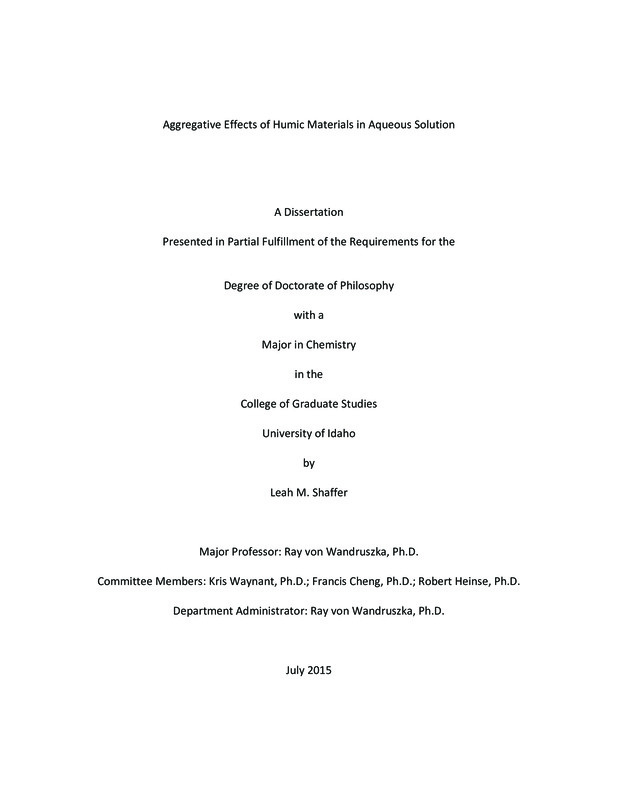Aggregative Effects of Humic Materials in Aqueous Solution
Shaffer, Leah Marie. (2015). Aggregative Effects of Humic Materials in Aqueous Solution. Theses and Dissertations Collection, University of Idaho Library Digital Collections. https://www.lib.uidaho.edu/digital/etd/items/shaffer_idaho_0089e_10690.html
- Title:
- Aggregative Effects of Humic Materials in Aqueous Solution
- Author:
- Shaffer, Leah Marie
- Date:
- 2015
- Keywords:
- aggregation humic humus PFOS soil sorption
- Program:
- Chemistry
- Subject Category:
- Chemistry; Environmental science
- Abstract:
-
The importance of the aggregative effects of humic polymers in soil systems has been well documented. The work described here was undertaken to further elucidate the aggregation of humates with an eye on both analysis and environmental gain. First, a quinone rich humic material was investigated to clarify the fluorescent effects that result from the conformational changes due to aggregation. Changes to the conformation of humic structure were found to lead to a sequestration of the quinone moieties that lie therein and enhance the fluorescence of these groups by separating them from the aqueous environment that quenches them. This resulted from ionic crosslinking between the carboxylic groups that are abundant in humic materials. The effect is environmentally relevant in view to the ability of humic materials to transport mineral cations through the soil.
This study formed the foundation for the next area of investigation, which dealt with the effect of temperature on the aggregation process. It was definitively shown that aggregation can be induced by raising the temperature of a humate solution that was “primed” by either lowering the pH or the addition of a divalent cations. An increase in temperature caused the dielectric constant of water to decrease, which in turn resulted in reduced hydration of the solute and the eventual collapse of the humic polymer into a dense aggregate.
The final area of investigation was the sorption of perfluorinated surfactants (PFSs) onto a crude humic solid, as well as a high carbon soil. PFSs have gained worldwide attention for their ubiquitous nature and bioaccumulation effects. It was found that their adsorption onto humates is highly pH due to the coulombic nature of the interactions. Both kinetic effects and isothermal sorption characteristics were investigated, and a number of commonly used models were tested. For the kinetic behavior, neither the pseudo-second order model, nor the intraparticle diffusion model gave entirely satisfactory results. The adsorption isotherms generally followed the Langmuir equation.
- Description:
- doctoral, Ph.D., Chemistry -- University of Idaho - College of Graduate Studies, 2015
- Major Professor:
- von Wandruszka, Ray
- Committee:
- Cheng, Francis I; Heinse, Robert; Waynant, Kristopher V
- Defense Date:
- 2015
- Identifier:
- Shaffer_idaho_0089E_10690
- Type:
- Text
- Format Original:
- Format:
- application/pdf
- Rights:
- In Copyright - Educational Use Permitted. For more information, please contact University of Idaho Library Special Collections and Archives Department at libspec@uidaho.edu.
- Standardized Rights:
- http://rightsstatements.org/vocab/InC-EDU/1.0/

